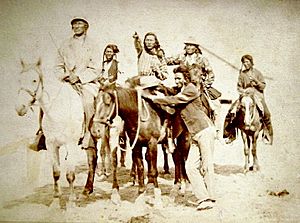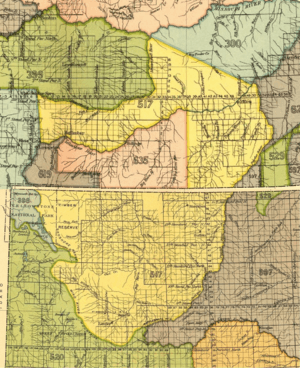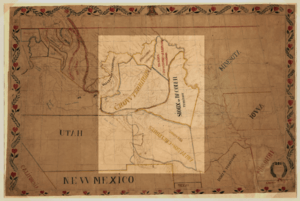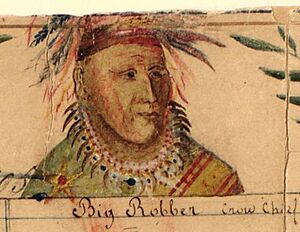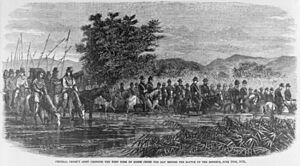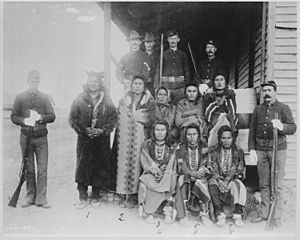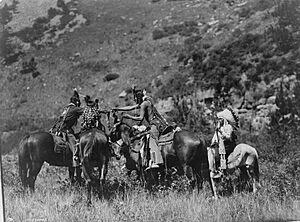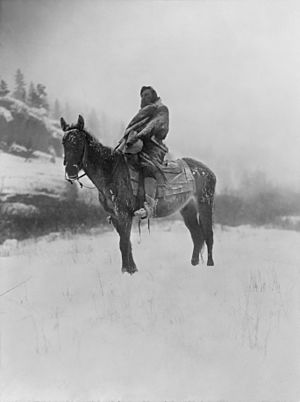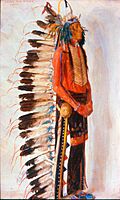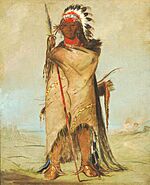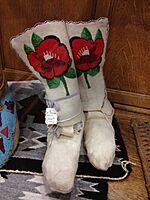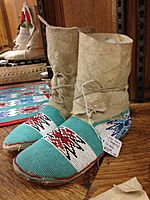Crow people facts for kids
| Apsáalooke | |
|---|---|
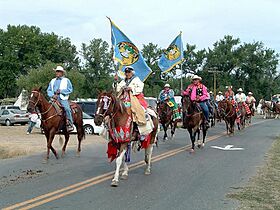
Pauline Small on horseback. She carries the flag of the Crow Tribe of Montana. As a tribal official, she is entitled to carry the flag during the Crow Fair parade.
|
|
| Total population | |
| 12,000 enrolled citizens | |
| Regions with significant populations | |
| United States (Montana) | |
| Languages | |
| Crow, English, Plains Sign Talk | |
| Religion | |
| Christianity, Crow Way, Tobacco Society | |
| Related ethnic groups | |
| Hidatsa |
| Apsáalooke "children of the raven" |
|
|---|---|
| People | Apsáalooke |
| Language | Apsáalooke aliláau Apsáalooke iiéhkuua |
| Country | Apsáalooke Issawua |
The Crow people, also known as Apsáalooke (pronounced Ahp-SAH-loo-keh), are a Native American tribe. They mostly live in southern Montana today. The Crow Tribe of Montana is a recognized tribe with its own land, called the Crow Indian Reservation. This reservation is in the south-central part of Montana.
The Crow are a Plains tribe. They speak the Crow language, which is part of the Siouan language family. In 2007, about 3,000 of their 14,000 members spoke the Crow language.
Long ago, the Crow lived in the Yellowstone River valley. This area stretched across parts of Wyoming, Montana, and North Dakota. As the United States expanded westward, the Crow often worked with the Americans. They did this against other tribes who were their rivals, like the Dakota, Lakota, and Cheyenne.
Since the 1800s, many Crow people have lived on their reservation near Billings, Montana. Today, some also live in big cities in the West. Their main offices are in Crow Agency, Montana. The tribe also runs the Little Big Horn College.
Contents
Understanding the Crow Name
The Crow people call themselves Apsáalooke. This name means "children of the large-beaked bird." It was given to them by the Hidatsa tribe, who were their neighbors and relatives. When French explorers heard this name, they translated it as "people of the crow." That's how the tribe became known as the Crow in English. Some Crow people believe the name refers to the powerful, mythical Thunderbird.
The Crow Story: A Look at Their Past
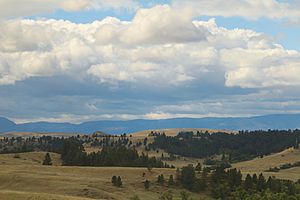
Early Migrations and New Lands
The Crow and their relatives, the Hidatsa, originally lived in the Ohio area. Around the 12th or 13th centuries, they moved west. They farmed and hunted bison in villages near Lake Winnipeg. Later, other tribes pushed them further west to the Missouri River.
The Crow then moved to North Dakota. In the late 1600s, they separated from the Hidatsa. They continued moving westward, partly because of pressure from the Cheyenne and Lakota (Sioux) tribes.
To claim their new lands, the Crow fought against some Shoshone groups. They also formed alliances with the Kiowa and Plains Apache tribes. The Crow became very strong in their territory during the 1700s and 1800s. This was a time when trading animal furs was very important.
Their traditional lands were vast. They stretched from what is now Yellowstone National Park in the west. They went north to the Musselshell River and east to the Missouri River. This area included many river valleys and mountain ranges.
Once they settled in the Yellowstone River valley, the Crow changed their way of life. They became nomadic hunters and gatherers, like other Plains Indians. They hunted bison and used dog travois to carry their belongings.
Friends and Foes: Crow Alliances
Around 1730, horses became common among Plains tribes. This made hunting bison much easier. The Crow, Hidatsa, and Shoshone became known for raising and trading horses. They had large herds.
However, other tribes also wanted horses and hunting grounds. The Crow faced raids and horse thefts from powerful tribes. These included the Blackfoot, Gros Ventre, Assiniboine, Pawnee, and Ute. Later, they also fought the Lakota, Arapaho, and Cheyenne. These tribes often stole horses from their enemies. The Blackfoot and the Lakota-Cheyenne-Arapaho alliance became their biggest rivals.
The Crow were generally friendly with tribes like the Flathead, Nez Perce, Kutenai, Shoshone, Kiowa, and Plains Apache.
Protecting Their Lands
As more European Americans arrived, the Crow faced many challenges. They were often outnumbered by their enemies. In the 1850s, a young boy named Plenty Coups had a special vision. Tribal elders believed it meant that white settlers would become powerful. They thought the Crow needed to stay friendly with the whites to keep their land. Plenty Coups later became a great chief.
By 1851, the Lakota and Cheyenne were moving closer to Crow territory. They wanted the Crow's rich hunting lands. Through battles, they took over some eastern Crow lands. This pushed the Crow further west along the Yellowstone River. After 1860, the Lakota Sioux claimed even more of the Crow's traditional lands.
The Fort Laramie Treaty of 1851 recognized a large area around the Big Horn Mountains as Crow land. However, the Lakota and Cheyenne continued to move west. They often ignored these treaty borders.
During Red Cloud's War (1866–1868), the Lakota Sioux fought against the United States. This war was about the Bozeman Trail, which crossed important bison hunting areas. The Lakota won this war. The 1868 Fort Laramie Treaty gave the Lakota control over even more land. This land had once been Crow territory.
In 1876, the Lakota Sioux and Cheyenne won a big battle against U.S. Army forces. This was the Battle of the Little Big Horn, which happened on the Crow Indian Reservation. However, the larger Great Sioux War (1876–1877) ended with the defeat of the Sioux and Cheyenne. Crow warriors actually joined the U.S. Army during this war. The Sioux and their allies were forced to move from eastern Montana and Wyoming. Some went to Canada, while others moved to reservations far from their homes.
Because of their cooperation with the U.S. government, the Crow were able to keep a large reservation. Many other tribes lost much more of their traditional lands.
In 1918, the Crow organized a gathering to share their culture. They invited members of other tribes. The Crow Fair is now held every year in August. Many tribes participate in this celebration.
Crow Culture and Traditions
Food and Hunting Practices
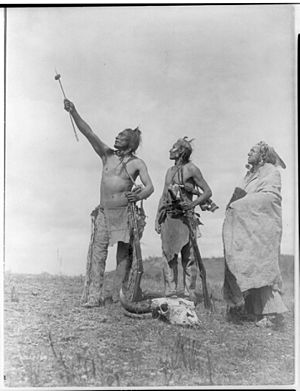
The main food for the Crow was the American bison. They hunted bison in many ways. Before horses, hunters would sneak close to the bison on foot. They often used a wolf-pelt disguise. Then they would chase the animals and kill them with arrows or spears.
Horses made bison hunting much easier. Riders could make the herd stampede. They would then shoot the bison with arrows or guns from horseback. They also used spears to hunt. Besides bison, the Crow hunted bighorn sheep, mountain goats, deer, elk, and bear.
Bison meat was often roasted or boiled in stews with prairie turnips. Parts like the rump, tongue, liver, heart, and kidneys were special treats. Dried bison meat was mixed with fat and berries to make pemmican. The Crow also gathered wild foods like elderberries, wild turnips, and Saskatoon berries.
The Crow often hunted bison by using buffalo jumps. One favorite spot was "Where Buffaloes are Driven Over Cliffs at Long Ridge." The Crow used this place every autumn for over a century. A medicine man would perform a ceremony before the hunt. He would sing sacred songs and ask the Great Spirit for success. This ritual helped guide the bison towards the cliffs.
Homes and Travel

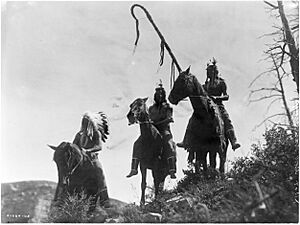
The traditional Crow home is the tipi or skin lodge. It is made from bison hides stretched over wooden poles. The Crow were known for building some of the largest tipis. The poles came from lodgepole pine trees.
Inside a tipi, mattresses and buffalo-hide seats were placed around the edge. A fireplace was in the center. Smoke escaped through a hole at the top. Tipis were easy to set up and take down. They were also lightweight, which was perfect for the nomadic Crow. When a tipi was taken down, the poles were used to make a travois. A travois is a frame pulled by a horse to carry belongings and children.
Many Crow families still own and use tipis today, especially when traveling. The annual Crow Fair is famous for having the largest gathering of tipis in the world.
Horses were the most common way for the Crow to travel. They got horses by trading and raiding other Plains tribes. The Crow had very large horse herds. In 1914, they had about thirty to forty thousand horses. Horses were very important to the Crow economy. They were valuable for trade and showed a warrior's wealth. Horses allowed the Crow to become skilled mounted warriors. They could perform amazing maneuvers during battles. Dogs were also used as guards and to pull travois before horses became widespread.
Traditional Clothing and Art
Crow clothing differed by gender. Women wore dresses made of deer and buffalo hide. These were decorated with elk teeth or shells. They wore leggings in winter and moccasins on their feet. Crow women often wore their hair in two braids.
Men's clothing usually included a shirt, leggings with a belt, a long breechcloth, and moccasins. They often wore robes made from bison fur in winter. Crow men wore their hair long, sometimes reaching the ground. They were known for wearing their hair in a pompadour, often colored with white paint. They also wore two hair pipes made from beads on each side of their hair. Bear grease was used to make hair shiny. Feathers from eagles, crows, and owls were worn for symbolic reasons.
The Crow wore various headdresses. These included the famous eagle feather headdress, bison scalp headdresses with horns, and split horn headdresses. The split horn headdress was made from a single bison horn, split and polished. Traditional Crow clothing is still worn today, especially for special events.
The Crow are famous for their detailed beadwork. They decorated almost everything with beads. This included clothing, horses, cradles, and ceremonial items. They used leather from buffalo, deer, and elk for their clothing and pouches. Crow women did this work, and some were experts. They even developed their own style of stitch-work, now called the "Crow Stitch."
In their beadwork, the Crow mostly used geometric shapes. Triangles, diamonds, and hourglass shapes were common. They used many colors, but blues and pinks were favorites. They often used a white outline to make certain colors or shapes stand out.
The colors had special meanings. Pinks represented the rising sun, with yellow for the East. Blues symbolized the sky. Red stood for the setting sun or the West. Green represented Mother Earth. Black meant the slaying of an enemy, and white represented clouds, rain, or sleet. While colors had common meanings, the meaning of shapes could be personal. A triangle might mean a tipi to one person, or a mountain range to another. Through their art, the Crow honored the land and sky.
Beaded clothing included robes, vests, pants, shirts, and moccasins. The designs often showed a person's achievements. For example, a warrior who defeated an enemy might have black added to his war clothing. A beaded robe given to a bride could take over a year to make. These robes often had parallel blue lines. These lines symbolized the young woman's new role as a wife and mother. Today, the Crow still decorate their clothing with beautiful bead designs for powwows and everyday wear.
-
Hó-ra-tó-a, a Crow warrior with headdress, bison robe, and hair reaching the ground. Painted by George Catlin, Fort Union 1832.
-
Crow moccasins
-
Crow moccasins, c. 1940
Family and Community Roles
The Crow had a matrilineal system. This means that family lines were traced through the mother. After marriage, a couple was matrilocal. This meant the husband moved to live with the wife's mother's family. Women held important roles within the tribe and community.
The Crow Tribe Today
Where the Crow Live: Geography
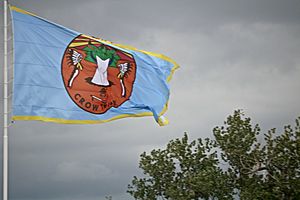
The Crow Indian Reservation is in south-central Montana. It covers about 2.3 million acres (3,600 square miles or 9,300 square kilometers). This makes it the fifth-largest Indian reservation in the United States. Most of the reservation is in Big Horn and Yellowstone counties.
The reservation's eastern border is the 107th meridian line, except where it meets the Northern Cheyenne Indian Reservation. The southern border runs from the 107th meridian west to the Big Horn River. The northern border goes east through Hardin, Montana. In 2000, 6,894 people lived on the reservation. Its largest town is Crow Agency.
How the Crow Tribe is Governed
The Crow Tribe of Montana has a government with three branches. This system was set up with their 2001 constitution. Before that, the tribe was governed by a general council. This council included all adult members of the tribe.
Today, the executive branch has four officials: a chairperson, vice-chairperson, secretary, and vice-secretary. The legislative branch has three members from each of the reservation's six districts. These districts are Valley of the Chiefs, Reno, Black Lodge, Mighty Few, Big Horn, and Pryor. The judicial branch includes all courts set up by Crow law. It works to be a separate part of the government. The current Chief Judge of the Crow Tribe is Julie Yarlott.
Important Leaders

The main government office and capital of the Crow Indian Reservation is Crow Agency, Montana. The Crow Tribe elects a chairperson for a four-year term. The chairperson leads the executive branch and is the main speaker for the tribal council.
Notable leaders include Clara Nomee, Edison Real Bird, and Robert Yellowtail. In 2008, Hartford and Mary Black Eagle of the Crow Tribe adopted U.S. Senator (and later President) Barack Obama into the tribe. This happened during his first visit to the nation as a presidential candidate. In 2009, Dr. Joe Medicine Crow received the Presidential Medal of Freedom. He was one of 16 people to get this high honor.
Notable Crow People

- Eldena Bear Don't Walk (Crow/Salish/Kutenai, born around 1973), a lawyer, judge, and politician. She was the first woman to be Chief Justice of the Crow Tribe.
- Max Big Man, an educator, artist, and honorary chief. He created educational programs with CBS Radio.
- Earl Biss (1947–1998), a talented painter.
- Bull Chief (born around 1825), a war chief who fought against many tribes and resisted white settlement.
- Curly (also known as Ashishishe/Shishi'esh, born around 1856 – 1923), an Indian Scout and warrior.
- Goes Ahead or Ba'suck'osh (also Walks Among the Stars, 1851–1919), an Indian Scout and warrior. He was the husband of Pretty Shield.
- Hairy Moccasin or Esh-sup-pee-me-shish (born around 1854 – 1922), a Crow Indian Scout and warrior.
- Half Yellow Face or Ischu Shi Dish (born around 1830 – around 1879), a Crow Indian Scout and warrior. He led six Crow Scouts who helped General George A. Custer.
- Issaatxalúash, also Two Leggings (mid-1840s – 1923); a local group leader and war leader during the early reservation era.
- Donald Laverdure, a Principal Deputy Assistant Secretary of Indian Affairs in the U.S. government.
- Joe Medicine Crow, also PédhitšhÎ-wahpášh (1913–2016), the last war chief of the Crow Tribe. He was an educator, historian, author, and official anthropologist.
- MELVIN PAUL WILLIAMSON; (born 1943) (Apsáalooke) known in rodeo for his skills as an all-around cowboy and for competing in many events.
- Elias Not Afraid; (born 1990) Apsáalooke (Crow/Absaroke) artist known for his traditional and modern beadwork.
- Janine Pease, an American Indian educator and advocate. She was the first woman of Crow lineage to earn a doctorate degree.
- Wendy Red Star, a visual artist.
- Plenty Coups, a Crow chief who worked with the government. This helped the Crow keep much of their traditional lands.
- Pretty Eagle, a war chief who worked with Plenty Coups to ensure cooperation with the federal government.
- Pretty Shield (born around 1856 – 1944), a medicine woman and wife of Goes Ahead.
- Shows as He Goes, a war chief.
- Pauline Small or Strikes Twice In One Summer (1924–2005), the first woman to serve in the Crow Tribal Council.
- Frank Shively (born around 1877), a football coach.
- Supaman, also Christian Parrish Takes the Gun, a rapper and fancy dancer.
- Noah Watts, also Bulaagawish (Old Bull), an actor and musician. He is known for his role as Ratonhnhaké:ton in Assassin's Creed III.
- Bethany Yellowtail (Crow/Northern Cheyenne), a fashion designer based in Los Angeles.
- Robert Yellowtail (1889–1988), a leader of the Crow Tribe. He was the first Native American to be an Agency Superintendent.
- Thomas Yellowtail (1903–1993), a medicine man and Sun Dance Chief of the Crow Tribe.
- White Man Runs Him (born around 1858 – 1929); a Crow Indian Scout and warrior. He was the step-grandfather of Joe Medicine Crow.
- White Swan, also Mee-nah-tsee-us (White Goose, born around 1850 – 1904), an Indian Scout and warrior. He was a cousin of Curly.
- Johnny Tim Yellowtail (born 1977) (Crow) Tribal Archeological Historian and speaker. He is known for his traditional dancing, singing, and knowledge of old Apsáalooke ceremonies.
See also
 In Spanish: Crow para niños
In Spanish: Crow para niños
- Absaroka: A proposed state that would have included parts of Montana, South Dakota, and Wyoming.
- Crow religion
- James Beckwourth: A Black chief of the Crow tribe.
- Pine Leaf: A female chief of the Crow tribe.


